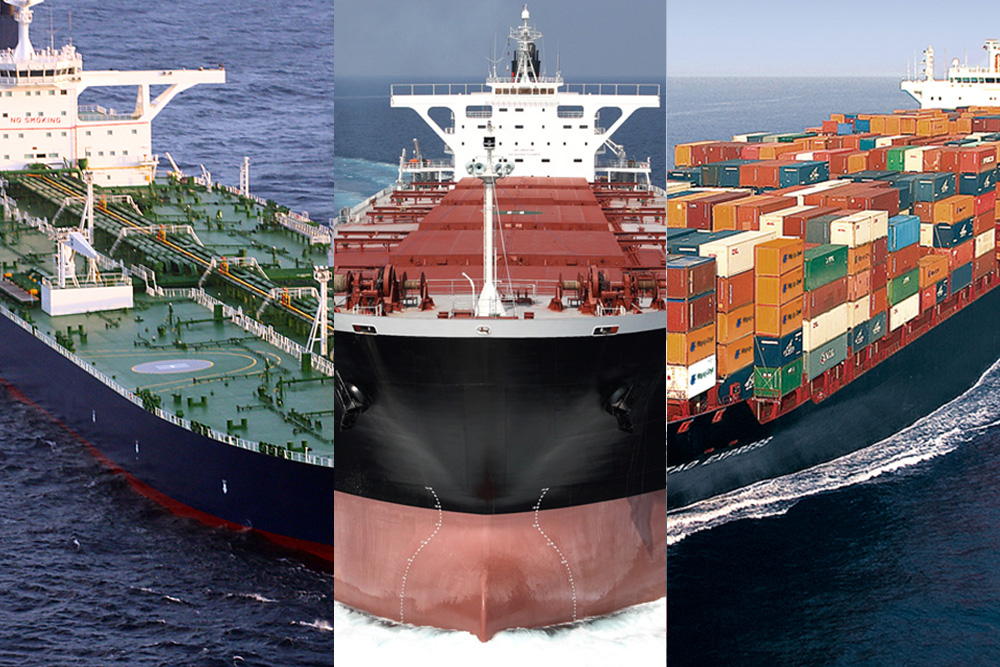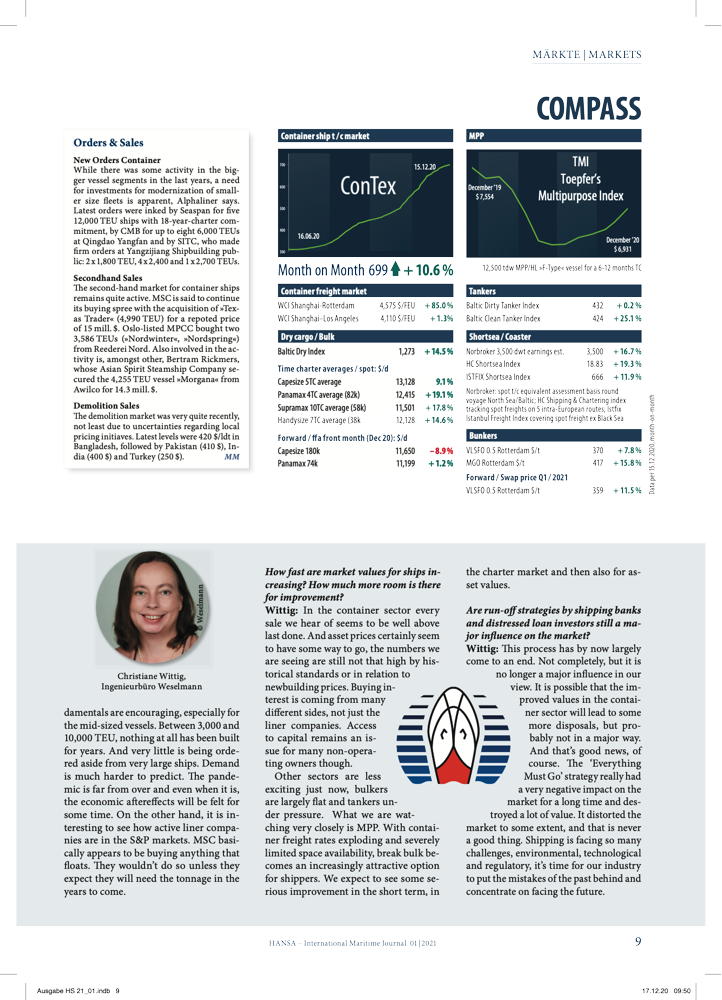Container and dry cargo trades are back on the growth path following a year of unseen turbulences.
Freight rates and vessel earnings across the container, dry bulk and mpp/heavy-lift segments were trending up in sync[ds_preview] in the final weeks of 2020, spilling some urgently needed cash into the pockets of shipowners. As in previous months, container shipping reaped the biggest gains on the back of wide-spread equipment and slot shortages. Freight rates kept scaling new heights on a weekly basis, driven by steep increases on the Far East/Europe route. Spot rates for China/North continent shipments have doubled in a short space of time to around 5,000$/FEU – an all-time high – and were expected to add another $1,500 as further general rate increases (GRI) became effective in the middle of December.
The freight spikes even eclipse those during the China boom of the early 2000’s, with anecdotal reports suggesting that some cargoes could be fixed at levels reaching 10,000$/FEU, all surcharges included. Lack of containers has been identified as the most important driver for rates these days. It seems the shortages had been coming for a while already as new container production in Asia was stuck at levels below replacement needs from summer 2019 to spring 2020, according to leading container lessor Triton.
Equipment orders only picked up in the second quarter and thus apparently too late for the massive rebound in container loadings in the third quarter. Factories are now full again, but it takes a few months for new boxes to deliver which means that larger volumes of extra equipment will only be phased in during this first quarter.
Current cargo boom has legs…
Shipping economists are still struggling to explain the current surge in cargo volumes. It is probably the combination of inventory rebuilding following the lockdowns of spring/summer 2020 and shift in consumer spending from services to physical goods, as the research division of Hamburg shipping group Peter Dohle points out. Add a bit more inefficiency and longer round-trip times for containers due to health and safety measures, and suddenly world container ship capacity is bursting at the seams. Latest available cargo statistics (on a global scale) by data provider CTS date back to October. They show a 4.6% year-on-year increase in global TEU loadings during the month, buoyed by a near 26% burst in volumes on the Far East/North America route. The increase in Far East/Europe is »only« 7.0% year-on-year. However, against the background of more or less unchanged service capacity on this corridor, the current capacity squeeze makes absolute sense.
Members of the Bremen Freight Forwarders Association (VBSp) said in a web conference that they expect the tightness and elevated freight rates to continue possibly until spring. Even the reactivation of more charter tonnage and ships coming out of maintenance could not bring about any relaxation during the final weeks of 2020. Idle statistics by Alphaliner implied that inactive container ship capacity had fallen to 1.2% by the end of November, against 5.7% a year earlier. Hamburg chartering firm Blue Net only considered three small feeder ships to be available at short notice. All the rest was tonnage berthed or drydocked at shipyards and vessels barred from trading due to sanctions or financial distress. Little surprise, the container ship charter market surged to the highest levels since 2011 after flirting with new lows in the second quarter.
Geared bulkers and MPP up
Market conditions in dry commodity shipping also took a positive turn towards the end of the year, with only the largest vessels (capesize) stuck at relatively low levels. The Baltic Dry Index posted a gain or more than 14% month-on-month as per middle of December, driven by improvements in panamax, supramax and handysize earnings.
In fact, the smaller geared bulkers (supra/handy) saw spot earnings climb to the highest levels since October 2019, with the 38,000 dwt type logging in more than 12,100$/day. Panamaxes rallied to a three-month high of 13,400$/day. As in the container trades, analysts highlighted a multitude of positive factors: a recovery in coal imports in China (from Indonesia etc.), exceptionally strong grain liftings ex North America and – important for the handy trades – a boost in scrap import demand in Turkey. Latest steel production data finally shows a recovery in the rest of the world outside China, spurring iron ore and coking coal shipments on smaller tonnage. Meanwhile, the multipurpose/heavy lift segment witnessed steady improvements, too, with the Toepfer index rate for 12,000 dwt F class vessels approaching $7,000 again. Chartering brokers and agents report severe capacity shortages for breakbulk shipments ex Europe while the high-end project cargo segment saw a notable cargo rush at the end of the year.
Orders & Sales
New Orders Container
While there was some activity in the bigger vessel segments in the last years, a need for investments for modernization of smaller size fleets is apparent, Alphaliner says. Latest orders were inked by Seaspan for five 12,000TEU ships with 18-year-charter commitment, by CMB for up to eight 6,000TEUs at Qingdao Yangfan and by SITC, who made firm orders at Yangzijiang Shipbuilding public: 2 x 1,800TEU, 4 x 2,400 and 1 x 2,700TEUs.
Secondhand Sales
The second-hand market for container ships remains quite active. MSC is said to continue its buying spree with the acquisition of »Texas Trader« (4,990TEU) for a repoted price of 15mill. $. Oslo-listed MPCC bought two 3,586TEUs (»Nordwinter«, »Nordspring«) from Reederei Nord. Also involved in the activity is, amongst other, Bertram Rickmers, whose Asian Spirit Steamship Company secured the 4,255TEU vessel »Morgana« from Awilco for 14.3mill. $.
Demolition Sales
The demolition market was very quite recently, not least due to uncertainties regarding local pricing initiaves. Latest levels were 420$/ldt in Bangladesh, followed by Pakistan (410$), India (400$) and Turkey (250$).
Michael Hollmann


















